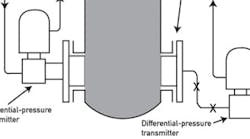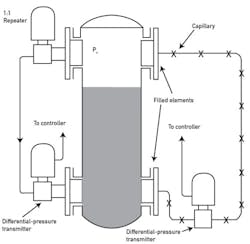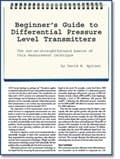Instead of having this 90-ft long impulse line, my plan is to not connect the low side of the DPT to the digester, but leave it open to atmosphere, and then add a pressure transmitter on top of the digester. The DCS system will then subtract the pressure measured by the DPT and the pressure transmitter to obtain the differential pressure to calculate level in the digester. Do you see any issue in this?
Samant Garg
[email protected]
A: The error contributions of each of your transmitters will be at least 0.1% FS and can often be additive. When the maximum level is 90 ft (39 psi) and assuming a vapor pressure of 100 psig, your system will result in an error of 0.1 + 0.04 = 0.24 psi = 6.65 ins. Add to that the errors if the vapor pressure is over 100 psi, or if the vendors overstated their accuracy, or the barometric pressure varies, or the sludge temperature, density or anaerobic activity changes, and foaming or zero shift occurs, etc. The 0.1% FS error will increase with time unless you have means for accurate and frequent recalibration. So, you can easily have an error of a foot. If you can live with that, your scheme is OK.
The other option (Figure 1) is to use one DPT with either a chemical seal (filled with non-freeze fluid), or if you have compressed air available, use a pressure repeater on the low-pressure side. With this system, you can cut the error in half.
Béla Lipták
[email protected]
A: In one of my earlier projects, we had a similar problem. And, being a corrosive service, we were using a diaphragm seal type DPT. As suggested by vendors, diaphragm seal lengths have a maximum height of 30 meters, above which the response time is very high. Hence, we went ahead with the same approach, using two pressure transmitters, and doing the difference calculation in the DCS.
Nilima Singh
[email protected]
A: Two parameters will help guide your choices:
First, what is the required accuracy of the level measurement? Is it ±1 ins. (25 mm) or ±3 in. (75 mm)?
Second, what is the static pressure in the vessel? Let's say it's 100 psig (about 7 barg). Then both the upper and lower transmitters will need to measure 100 psig± (half of your required level accuracy). Is measuring 100 ± 0.02 psi (for the 1-in. case) plausible? It might be with the right accuracy transmitter and long-term stability specification (you probably don't want to be compelled to check calibration once a week, for example).
If the static pressure is 2 psig, then it becomes very plausible with garden-variety pressure instruments, I think, with 1% combined uncertainty from drift, temperature effects, calibration accuracy, etc.
Each transmitter contributes a measure of uncertainty and drift. They may cancel out, or they may be additive. We don't know. It's possible to do what you propose successfully, but you have to specify the instruments more carefully. You may have to spend a little more to achieve the accuracy and long-term stability your end user will require. All the defects and uncertainty of your static pressure measurements (including process noise) will potentially be magnified in the level calculation.
John Rezabek
[email protected]
A: I think I would favor the electronic subtraction method. I would probably also favor a flush-face diaphragm style PT for the digester bottom (and maybe for the top too, depending on available mounting) over of some kind of purging. Check to see if the diaphragm materials will hold up to your sludge and digester gas. I have seen, for instance, some SS diaphragms pin-hole due to small impurities.
Al Pawlowski, PE
[email protected]
A: The achieved accuracy depends on the operating pressure of the digester. The higher the pressure, the worse the accuracy. The span of the DP transmitter at the bottom now has to be much greater, and has to include the operating pressure of the digester. Hence, the percent accuracy converted to the actual measurement is a bigger number.
If the DPT is connected to the digester in the traditional way, accuracy is based purely on the pressure equivalent to the height of the digester (i.e., 90 ft of the liquid). For example, 90 ft of water is equivalent to a span of approximately 40 psi. The accuracy of ±0.1% transmitter for 90 ft is approximately 1 in. For an operating pressure of 200 psi, the accuracy of ±0.1% transmitter gives a level accuracy of 5 in. Furthermore, this accuracy is the best you can get, and does not include the rangeability of the transmitter and other installation effects.
Simon Lucchini
[email protected]
A: I would not recommend using the DCS controller to compute the level by subtraction of pressures taken by two different instruments. Ideally, it should work, and it may work initially if you allow a tuning factor in the calculation, and then tune it for an actual measured level. DP cells work because there is one and only one sensor. Calibration of two different sensors is unlikely to produce a sustainable accurate measurement.
Dick Caro
[email protected]
A: It seems likely that the pressure in the top of the digester will be relatively low; using a pneumatic repeater with at most 1-in. WG error is a clean solution. These have been used for many years in the paper industry, and as a titanium diaphragm with a nozzle generating a 1:1 pneumatic duplication, they work well. The latest variation on this theme is the Rosemount electronic seal system, which connects the top pressure sensor to a bottom pressure sensor with a HART communication link, and the bottom unit then has 4-20 mA (IS) and HART giving DP, pressure and sensor temperatures as well.
However, bear in mind that the radar will be trying to measure a layer of foam on the top of the tank, and the DP is assuming the contents of the tank are at a constant known density. As the digester is anaerobically making methane/CO2, both measurements have innate errors. The density of the sludge will vary from bottom to top. Near the top, the density may be somewhere between 700 kg/m3 and 900 kg/m3. You may need to measure the DP near the top to get less error (or even do a DP density measurement) to correct the level.
IanH.Gibson
[email protected]
[javascriptSnippet]







